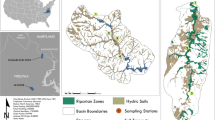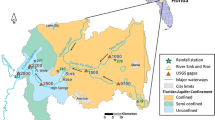Abstract
Understanding interactions between permanently frozen soils and stream chemistry is important in predicting the effects of management, natural disturbance and changing permafrost distribution on stream ecosystems and nutrient budgets in subarctic watersheds. Chemical measurements of groundwater, soil water and stream water were made in two watersheds in the taiga of interior Alaska. One watershed (HiP) had extensive permafrost and the other (LoP) had limited permafrost. Soil water collected within the rooting zone (0.3–0.5 m) in both watersheds was high in dissolved organic carbon (DOC), dissolved organic nitrogen (DON) and dissolved inorganic nitrogen (DIN) but low in dissolved minerals (dominantly Ca, Mg and Na) and conductivity. The reverse was true for groundwater from springs and wells. Permafrost in the HiP basin prevented deep percolation of water and generated stormflows rich in DOC. The presence of permafrost in HiP resulted in higher fluxes of DOC, DON and DIN into stream water from upland soils.
Similar content being viewed by others
References
Aber JD, Mellilo JM, Nadelhoffer KJ, Pastor J & Boone RD (1989) Factors controlling N cycling and N saturation in northern temperate forest ecosystems. Ecol. Appl. 1: 303–315
Allan JD (1995) Stream Ecology. Chapman and Hall, London, U.K.
American Public Health Association, American Water Works Association, and Water Pollution Control Federation (1985) Standard Methods for the Examination of Water and Wastewater, 16th edn. Washington DC, U.S.A.
Cauwet G (1994) HTCO method for dissolved organic carbon analysis in seawater: Influence of catalyst on blank estimation. Marine Chemistry 47: 55–64
Van Cleve K, Barney R & Schlentner R 1981 Evidence of temperature control of production and nutrient cycling in two interior Alaska black spruce ecosystems. Can. J. For. Res. 11: 258–273
Van Cleve K, Oliver L, Schlentner R, Viereck LA & Dyrness CT (1983) Productivity and nutrient cycling in taiga forest ecosystems. Can. J. For. Res. 13: 747–766
Conover WJ & Inman RL (1981) Rank transformations as a bridge between parametric and nonparametric statistics. Am. Statistician 35: 124–129
Buttle JM & Fraser KE (1992) Hydrochemical fluxes in a high arctic wetland during spring snowmelt. Arct. Alp. Res. 24: 153–164
Evans A Jr (1986) Effects of dissolved organic carbon and sulfate on aluminium mobilization in forest soil columns. Soil Sci. Soc. Am. J. 50: 1576–1578
Everett KR, Kane DL & Hinzman LD (1996) Surface water chemistry and hydrology of a small arctic drainage basin. In: Reynolds JF & Tenhunen JD (Eds) Landscape Function and Disturbance in Arctic Tundra (pp 185–201). Ecological Studies 120, Springer, Berlin, Germany.
Fiebig DM & Lock MA (1991) Immobilization of dissolved organic matter from groundwater discharging through the stream bed. Freshwater Biol. 26: 45–55
Ford TR (1973) Precipitation runoff characteristics of the Caribou Creek research watershed near Fairbanks, Alaska. MS Thesis, University of Alaska Fairbanks, AK, U.S.A.
Ford TE & Naiman RJ (1989) Groundwater — surface water relationships in boreal forest watersheds: Dissolved organic carbon and inorganic nutrient dynamics. Can. J. Fish. Aquat. Sci. 46: 41–49
Glantz SA & Slinker BK (1990) Primer of Applied Regression and Analysis of Variance. McGraw-Hill, New York, U.S.A.
Haugen RK, Slaughter CW, Howe KE & Dingman SL (1982). Hydrology and climatology of the Caribou-Poker creeks research watershed, Alaska. CRREL Report No 82-26, US Army Corps of Engineers, Cold Regions Research and Engineering Laboratory, Hanover, NH, U.S.A.
Hedin LO, Arnesto JJ & Johnson AH (1995) Patterns of nutrient loss from unppolluted, old growth temperate forests: evaluation of biogeochemical theory. Ecology 76: 493–509
Jardine PM, Weber NL & McCarthy JF (1989) Mechanisms of dissolved organic carbon absorption on soil. Soil Sci. Soc. Am. J. 53: 1378–1385
Kling GW, O'Brien WJ, Miller MC & Hershey AE (1992) The biogeochemistry and zoogeographyof lakes and rivers in arctic Alaska. Hydrobiol. 240: 1–14
Koprivnjak JF & Moore TR (1992) Sources, sinks and fluxes of dissolved organic carbon in subarctic fen catchments. Arct. Alp. Res. 24: 204–210
Koutz FR & Slaughter CW (1973) Equivalent latitude and a permafrost environment. CRREL Technical Note, US Army Corps of Engineers, Cold Regions Research and Engineering Laboratory, Hanover, NH, U.S.A.
Likens GE & Borman FH (1995) Biogeochemistry of a Forested Ecosystem, 2nd edn. Springer Verlag Publishers, New York, U.S.A.
Linsley RK, Kohler MA & Paulhus JCH (1982) Hydrology for Engineers. McGraw Hill Publishers, New York, U.S.A.
Lock MA & Ford TE (1986) Colloidal and dissolved organic carbon dynamics in undisturbed boreal forest catchments: A seasonal study of apparent molecular weight spectra. Freshwater Biol. 16: 187–195
Lock MA, Ford TE, Fiebig DM, Miller MC, Hullar M, Kaufman M, Vestal JR, Peterson BJ & Hobbie JE (1989) A biogeochemical survey of rivers and streams in the mountains and foot-hills province of arctic Alaska. Arch. Hydrobiol. 115: 499–521
McDowell WH & Wood T (1984) Podzolization: Soil processes control dissolved organic carbon concentrations in stream water. Soil Science 137: 23–31
McDowell WH (1985) Kinetics and mechanisms of dissolved organic carbon retention in a headwater stream. Biogeochemistry 1: 329–352
McNamara JP, Kane DL & Hinzman LD (1997) Hydrograph separations in an arctic watershed using mixing-model and graphical techniques. Water Resour. Res. 33: 1707–1720
Merriam J, McDowell WH & Currie WS (1996) A high temperature catalytic oxidation technique for determining total dissolved nitrogen. Soil. Sci. Soc. Am. J. 60: 1050–1055
Naiman, RJ (1982) Characteristics of Sediment and Organic Carbon Export from Pristine Boreal Forest Watersheds. Can. J. Fish. Aquat. Sci. 39: 1699–1718
National Atmospheric Deposition Program (unpublished data) Internet address for data (URL): http://nadp.nrel.colostate.edu/NADP
National Weather Service (unpublished data) Climate summary for Fairbanks. Internet address for data (URL): http://www.wrcc.sage.dri.edu
Neter J, Wasserman W & Kutner MH (1990) Applied Linear Statistical models, 3rd edn. Irwin, Boston, U.S.A.
Oswood MW, Irons JG III & Schell DM (1996) Dynamics of dissolved and particulate carbon in a tundra stream in arctic Alaska. In: Reynolds JF & Tenhunen JD (Eds) Landscape Function and Disturbance in Arctic Tundra (pp 275–287). Ecological Studies 120, Springer, Berlin, Germany
Pearce AJ, Stewart MR & Sklash MG (1986) Storm runoff generation in humid headwater catchments 1: Where does the water come from? Water Resour. Res. 22: 1263–1271
Peterson BJ, Hobbie JE & Corliss TL (1986) Carbon flow in a tundra stream ecosystem. Can. J. Fish. Aquat. Sci. 43: 1259–1270
Peterson BJ, Corliss T, Kriet K & Hobbie JE (1992) Nitrogen and phosphorus concentrations and export for the upper Kuparak River on the North Slope of Alaska in 1980. Hydrobiol. 240: 61–69
Pohlman AA & McColl JG (1988) Soluble organics from forest litter and their role in metal dissolution. Soil Sci. Soc. Am. J. 52: 265–271
Qualls RG & Haines BL (1991) Geochemistry of dissolved organic nutrients in water percolating through a forest ecosystem. Soil. Sci. Soc. Am. J. 55: 1112–1123
Ray SR (1988) Physical and chemical characteristics of headwater streams at Caribou-Poker creeks research watershed. MS thesis, University of Alaska Fairbanks, Fairbanks, Alaska
Rieger S, Furbush, CE, Schoephorster DB, Summerfield H & Geiger LC Jr (1972) Soils of the Caribou-Poker creeks research watershed, Interior Alaska. CRREL Technical Report 236, US Army Corps of Engineers, Cold Regions Research and Engineering Laboratory, Hanover, NH, U.S.A.
Slaughter CW & Kane DL (1979) Hydrologic role of shallow organic soils in cold climates In: Canadian Hydrology Symposium 79 —Cold Climate Hydrology. National Research Council of Canada (pp 380–389)
Shaver GR, Nadelhoffer KJ & Giblin AE (1991) Biogeochemical diversity and element transport in a heterogeneous landscape, the North Slope of Alaska. In: Turner MG & Gardner RH (Eds) Quantitative Methods in Landscape Ecology; The Analysis and Interpretation of Landscape Heterogeneity (pp 105–125). Ecological Studies 82, Springer, Berlin, Germany
Swank WT & Waide JB (1988) Characterization of baseline precipitation and nutrient budgets for control watersheds. In: Swank WT & Crossley DA (Eds) Forest Hydrology and Ecology at Coweeta (pp 57–79). Springer Verlag, New York, U.S.A.
Troth JL, Deneke FJ & Brown LM (1976) Upland aspen/birch and black spruce stands and their litter and soils properties in interior Alaska. For. Sci. 22: 33–44
Viereck LA, Dyrness CT, Van Cleve K & Foote MJ (1983) Vegetation, soils and forest productivity in selected forest types in interior Alaska. Can. J. For. Res. 13: 703–720
Wallis PM, Hynes H & Telang SA (1981) The importance of groundwater in the transportation of allochthonous dissolved organic matter to streams draining a small mountain basin Hydrobiologia 79: 77–90
White JD, Koepke BE & Swanson DK (1995) Soil survey of North Star Area, Alaska, Interim Report. US Department of Agriculture Natural Resources Conservation Service
Willard HH, Merrit LL, Dean JA & Settle FA Jr (1981) Instrumental Methods of Analysis, 6th edn. D Van Nostrand Publishers, New York, U.S.A.
Woo MK (1986) Permafrost hydrology in North America. Atmos. Ocean 24: 201–234
Woo MK & Winter TC (1993) The role of permafrost and seasonal frost in the hydrology of northern wetlands in North America. J. Hydrol. 141: 5–31
Author information
Authors and Affiliations
Rights and permissions
About this article
Cite this article
MacLean, R., Oswood, M.W., Irons, J.G. et al. The effect of permafrost on stream biogeochemistry: A case study of two streams in the Alaskan (U.S.A.) taiga. Biogeochemistry 47, 239–267 (1999). https://doi.org/10.1007/BF00992909
Received:
Accepted:
Issue Date:
DOI: https://doi.org/10.1007/BF00992909




